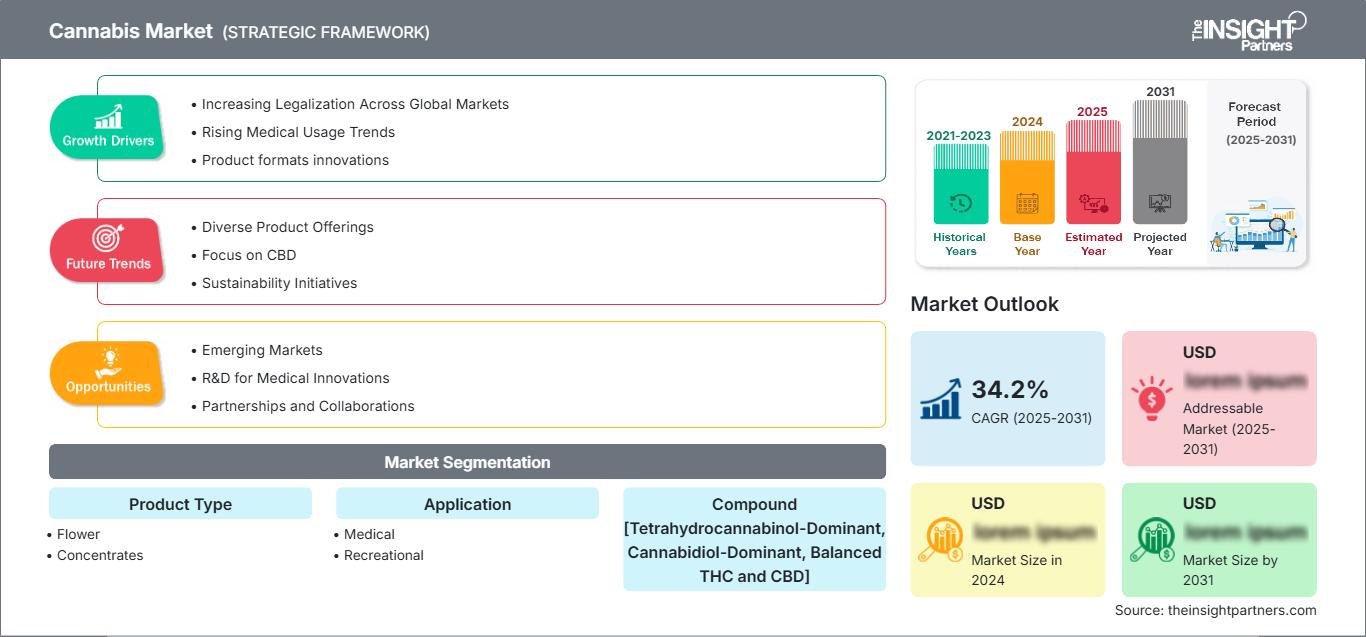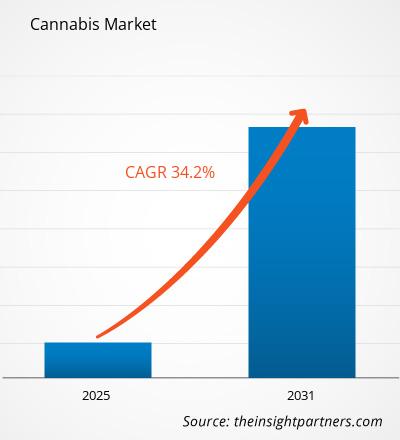Der Cannabis-Markt wird bis 2031 voraussichtlich ein Volumen von 193,36 Milliarden US-Dollar erreichen. Für den Zeitraum 2025–2031 wird ein jährliches Wachstum von 20,5 % erwartet.
Der Bericht zum Cannabis-Markt analysiert den Markt nach Produkttyp (Blüten, Konzentrate und Sonstiges), Anwendung (medizinisch und Freizeit) sowie Wirkstoff (THC-dominant, CBD-dominant, ausgewogenes THC/CBD-Verhältnis). Die globale Analyse wird zudem auf regionaler Ebene und für wichtige Länder aufgeschlüsselt. Der Bericht gibt die Werte der oben genannten Analysen und Segmente in US-Dollar an. Ziel des Berichts ist es, die aktuelle Marktlage und das zukünftige Wachstum, die wichtigsten Wachstumstreiber, Herausforderungen und Chancen zu beschreiben. Dies wird verschiedenen Akteuren im Geschäftsbereich Einblicke ermöglichen, wie beispielsweise:
- Technologieanbieter/Hersteller: Um die sich entwickelnde Marktdynamik zu verstehen und potenzielle Wachstumschancen zu erkennen, können sie fundierte strategische Entscheidungen treffen.
- Investoren: Um eine umfassende Trendanalyse hinsichtlich Marktwachstumsrate, Finanzprognosen und Chancen entlang der Wertschöpfungskette durchzuführen.
- Regulierungsbehörden: Um Richtlinien zu regulieren und Aktivitäten auf dem Markt zu überwachen, mit dem Ziel, Missbrauch zu minimieren, das Vertrauen der Anleger zu wahren und die Integrität und Stabilität des Marktes zu gewährleisten.
Marktsegmentierung Cannabis Produkttyp
- Blüten
- Konzentrate
Anwendung
- Medizinisch
- Freizeit
Zusammensetzung [THC-dominant, CBD-dominant, Ausgewogenes THC- und CBD-Verhältnis]
Geografie
- Nordamerika
- Europa
- Asien-Pazifik
- Süd- und Mittelamerika
- Naher Osten und Afrika
Sie erhalten kostenlos Anpassungen an jedem Bericht, einschließlich Teilen dieses Berichts oder einer Analyse auf Länderebene, eines Excel-Datenpakets sowie tolle Angebote und Rabatte für Start-ups und Universitäten.
Cannabismarkt: Strategische Einblicke

- Holen Sie sich die wichtigsten Markttrends aus diesem Bericht.Dieses KOSTENLOSE Beispiel umfasst Datenanalysen, die von Markttrends bis hin zu Schätzungen und Prognosen reichen.
Wachstumstreiber des Cannabismarktes
- Zunehmende Legalisierung weltweit: Der Markt wird wachsen, da die Legalisierung von medizinischem und Freizeit-Cannabis weltweit zunimmt.
- Steigende Trends bei der medizinischen Anwendung: Markttrends deuten auf eine verstärkte Nutzung von Cannabis zur Behandlung chronischer Schmerzen und neurologischer Erkrankungen hin, was zum weltweiten Marktwachstum beiträgt.
- Innovationen bei Produktformaten: Wettbewerbsanalysen zeigen verschiedene neue Darreichungsformen wie Esswaren und topische Produkte, die unterschiedliche Verbraucherpräferenzen bedienen und den Markt erweitern.
Zukünftige Trends des Cannabismarktes
- Vielfältiges Produktangebot: Der Markt entwickelt sich hin zu innovativen Produktformaten, darunter Esswaren, Getränke, Öle und topische Produkte, um den unterschiedlichen Verbraucherpräferenzen gerecht zu werden.
- Fokus auf CBD: Cannabidiol (CBD), eine nicht-psychoaktive Verbindung, gewinnt in Gesundheits- und Wellnessprodukten an Popularität und spricht gesundheitsbewusste Verbraucher an. Nachhaltigkeitsinitiativen: Die Cannabisbranche setzt auf umweltfreundliche Anbau- und Produktionsmethoden, um ihre Umweltbelastung zu reduzieren.
Marktchancen für Cannabis
- Aufstrebende Märkte: Länder im asiatisch-pazifischen Raum, Lateinamerika und Europa prüfen die Legalisierung von Cannabis und eröffnen damit neue Wachstumschancen.
- Forschung und Entwicklung für medizinische Innovationen: Investitionen in die Forschung erweitern das Verständnis der medizinischen Anwendungsmöglichkeiten von Cannabis und eröffnen neue Wege für die Produktentwicklung.
- Partnerschaften und Kooperationen: Kooperationen zwischen Cannabisunternehmen und Pharma- oder Konsumgüterunternehmen fördern Innovation und Marktdurchdringung.
Cannabismarkt
Die regionalen Trends und Einflussfaktoren auf den Cannabis-Markt im gesamten Prognosezeitraum wurden von den Analysten von The Insight Partners ausführlich erläutert. Dieser Abschnitt behandelt außerdem die Marktsegmente und die geografische Verteilung des Marktes für die Behandlung von Herzrhythmusstörungen in Nordamerika, Europa, dem asiatisch-pazifischen Raum, dem Nahen Osten und Afrika sowie Süd- und Mittelamerika.
Umfang des Cannabis-Marktberichts
| Berichtsattribut | Einzelheiten |
|---|---|
| Marktgröße in 2024 | US$ XX Billion |
| Marktgröße nach 2031 | US$ 193.36 Billion |
| Globale CAGR (2025 - 2031) | 20.5% |
| Historische Daten | 2021-2023 |
| Prognosezeitraum | 2025-2031 |
| Abgedeckte Segmente |
By Produkttyp
|
| Abgedeckte Regionen und Länder | Nordamerika
|
| Marktführer und wichtige Unternehmensprofile |
|
Dichte der Akteure auf dem Cannabismarkt: Auswirkungen auf die Geschäftsdynamik
Der Cannabis-Markt wächst rasant, angetrieben durch die steigende Nachfrage der Endverbraucher. Gründe hierfür sind unter anderem sich wandelnde Verbraucherpräferenzen, technologische Fortschritte und ein wachsendes Bewusstsein für die Vorteile des Produkts. Mit steigender Nachfrage erweitern Unternehmen ihr Angebot, entwickeln innovative Lösungen, um den Bedürfnissen der Verbraucher gerecht zu werden, und nutzen neue Trends, was das Marktwachstum weiter ankurbelt.

- Holen Sie sich die Cannabismarkt Übersicht der wichtigsten Akteure
Wichtigste Verkaufsargumente
- Umfassende Abdeckung: Der Bericht bietet eine umfassende Analyse der Produkte, Dienstleistungen, Arten und Endnutzer des Cannabis-Marktes und vermittelt so ein ganzheitliches Bild.
- Expertenanalyse: Der Bericht basiert auf dem fundierten Wissen von Branchenexperten und Analysten.
- Aktuelle Informationen: Der Bericht gewährleistet Geschäftsrelevanz durch die Berücksichtigung aktueller Informationen und Datentrends.
- Anpassungsmöglichkeiten: Dieser Bericht kann an spezifische Kundenanforderungen angepasst werden und sich optimal in die Geschäftsstrategien integrieren.
Der Forschungsbericht zum Cannabis-Markt kann somit maßgeblich dazu beitragen, das Branchenszenario und die Wachstumsaussichten zu entschlüsseln und zu verstehen. Auch wenn einige berechtigte Bedenken bestehen, überwiegen die Vorteile dieses Berichts insgesamt die Nachteile.
- Historische Analyse (2 Jahre), Basisjahr, Prognose (7 Jahre) mit CAGR
- PEST- und SWOT-Analyse
- Marktgröße Wert/Volumen – Global, Regional, Land
- Branchen- und Wettbewerbslandschaft
- Excel-Datensatz
Aktuelle Berichte
Erfahrungsberichte
Grund zum Kauf
- Fundierte Entscheidungsfindung
- Marktdynamik verstehen
- Wettbewerbsanalyse
- Kundeneinblicke
- Marktprognosen
- Risikominimierung
- Strategische Planung
- Investitionsbegründung
- Identifizierung neuer Märkte
- Verbesserung von Marketingstrategien
- Steigerung der Betriebseffizienz
- Anpassung an regulatorische Trends




















 Kostenlose Probe anfordern für - Cannabismarkt
Kostenlose Probe anfordern für - Cannabismarkt